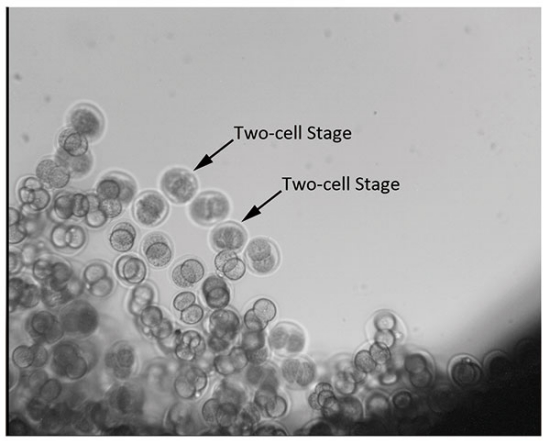

Duan Enkui, researcher of the Institute of Zoology, Chinese Academy of Sciences, and also the leader of the project, introduces the development of the mammal embryos in space in Ulanqab City, north China's Inner Mongolia Autonomous Region, April 17, 2016. Over 6,000 early-stage mouse embryos carried by China's retrievable scientific research satellite have developed in space, making it the world's first-ever successful test on mammal embryo development. (Xinhua/Wang Quanchao)
Chinese scientists on Sunday said they have successfully developed early-stage mouse embryos in space for the first time on a retrievable microgravity satellite set to return to Earth sometime next week.
The SJ-10 research probe, launched on April 6, carried over 6,000 mouse embryos in a self-sufficient chamber the size of a microwave oven, according to Duan Enkui, a researcher with the Chinese Academy of Sciences (CAS).
Among them, 600 embryos were put under a high-resolution camera, which took pictures every four hours for four days and sent them back to Earth.
The pictures showed that the embryos developed from the 2-cell stage, an early-on embryonic cleavage stage, to blastocyst, the stage where noticeable cell differentiation occurs, around 72 hours after SJ-10's launch, Duan said. The timing was largely in line with embryonic development on Earth, he added.

Photo provided by the Institute of Zoology, Chinese Academy of Sciences, shows the mouse embryos four hours before they are launched into space by the satellite, SJ-10. Over 6,000 early-stage mouse embryos carried by China's retrievable scientific research satellite have developed in space, making it the world's first-ever successful test on mammal embryo development.
The rest of the embryos loaded on the satellite were injected with fixatives at 72 hours after the launch for studies on the effects of space environment on embryonic development, according to Duan.
This is the first reported successful development in mammalian embryos in space in human history.
Scientists will compare the retrieved embryos with samples on Earth and perform further analyses on the profiles of early embryo development in space, once SJ-10 returns home.
SJ-10 is expected to land in a designated spot in Siziwang Banner in Inner Mongolia sometime next week. Earlier reports said the probe as a whole had a designed life of just 15 days.
The bullet-shaped probe is said to be housing a total of 19 experiments involving microgravity fluid physics, microgravity combustion, space material, space radiation effects, microgravity biological effects and space bio-technology.
These include one studying how space radiation affects the genetic stability of fruit flies and rat cells, and a combustion experiment which will test how materials used in spacecraft burn in space to find ways of making safer capsules for future manned missions.

Photo provided by the Institute of Zoology, Chinese Academy of Sciences, shows the blastocysts developed from cells 80 hours after the mouse embryos were launched into space by the satellite, SJ-10. Over 6,000 early-stage mouse embryos carried by China's retrievable scientific research satellite have developed in space, making it the world's first-ever successful test on mammal embryo development.
An experiment being run in partnership between the National Space Science Center under the CAS and the European Space Agency will investigate the behavior of crude oil under high pressure, and also on board is equipment to test coal combustion and pollutant formation under microgravity.
The former experiment is aimed at improving scientists' understanding of oil reservoirs buried deep underground, while the latter is expected to help enhance energy efficiency and cut emissions on Earth.
In a separate development, retrievers for the SJ-10 satellite on Sunday said they will deploy four helicopters to aid ground vehicles in the search for the satellite after its landing next week. (Xinhua)

86-10-68597521 (day)
86-10-68597289 (night)

86-10-68511095 (day)
86-10-68512458 (night)

cas_en@cas.cn

52 Sanlihe Rd., Xicheng District,
Beijing, China (100864)

